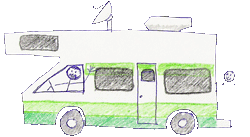The Pacific Coast
On Sunday the 11th, we left the Olympic Peninsula and headed southwest to one of our favorite campgrounds, Cape Disappointment. It is at the mouth of the Columbia river, on the Washington side. There we met members of the Malen family that we had seen at the end of July at the family reunion. Laddy, Pris's cousin, brought along a slab of Salmon that he had caught earlier in the Columbia. We grilled it up and made general pigs of ourselves.
The weather was cold and rainy when we arrived but improved after the first night. That allowed us to start hiking again. The first photo shows one of the light houses just inside the north jetty of the Columbia, reached on one of our hikes.
On Wednesday, we crossed into Oregon and headed south. We enjoyed great weather and scenery! The second photo is an example of the Oregon coast at its best. For our Florida friends, it is not at all like Cocoa beach! We spent Wednesday and Thursday nights at William Tubman State Park. We had not been here before and enjoyed the privacy. The park is located near the Oregon Dunes NRA. The dunes are 40 miles long and can reach heights of more than 500 feet. They provide an impressive view while driving down the highway. On Friday it was on to Brookings, Oregon, just above the California border. We stayed at a private campground in Brookings, that had full hookups. That was necessary to ensure that I could see the Florida-Tennessee football game on Saturday. Everything worked out great, I saw the game and we won! The Oregon coast drive is one of the most beautiful drives in the country. There are many viewpoints along the road where you can see waves crashing on the rocks, numerous lighthouses, birds, seals, and sea lions. There are numerous state campgrounds with gorgeous views located on this highway. It's also a favorite route for bicyclists who can travel all the way down the entire coast of Oregon.
On Sunday the 18th, we headed south for California. After 45 minutes driving, we stopped for breakfast south of Crescent City, right off the beach. The third photo shows the gorgeous weather and views we had. One of the joys of traveling in our motor home is the ability to pull off the road at a beautiful spot and make our own breakfast or lunch. Besides the touring and eating regional food, another thing that we have enjoyed is meeting people from different parts of the country. Everyone is friendly and out and enjoying doing what we like to do. We have met people from ND taking their son to his freshmen year at WSU to a lady who mushes her Malmuts at the Ocean Dunes Recreational Area and lots of people in between. It is good to be out in the USA.
The weather was cold and rainy when we arrived but improved after the first night. That allowed us to start hiking again. The first photo shows one of the light houses just inside the north jetty of the Columbia, reached on one of our hikes.
On Wednesday, we crossed into Oregon and headed south. We enjoyed great weather and scenery! The second photo is an example of the Oregon coast at its best. For our Florida friends, it is not at all like Cocoa beach! We spent Wednesday and Thursday nights at William Tubman State Park. We had not been here before and enjoyed the privacy. The park is located near the Oregon Dunes NRA. The dunes are 40 miles long and can reach heights of more than 500 feet. They provide an impressive view while driving down the highway. On Friday it was on to Brookings, Oregon, just above the California border. We stayed at a private campground in Brookings, that had full hookups. That was necessary to ensure that I could see the Florida-Tennessee football game on Saturday. Everything worked out great, I saw the game and we won! The Oregon coast drive is one of the most beautiful drives in the country. There are many viewpoints along the road where you can see waves crashing on the rocks, numerous lighthouses, birds, seals, and sea lions. There are numerous state campgrounds with gorgeous views located on this highway. It's also a favorite route for bicyclists who can travel all the way down the entire coast of Oregon.
On Sunday the 18th, we headed south for California. After 45 minutes driving, we stopped for breakfast south of Crescent City, right off the beach. The third photo shows the gorgeous weather and views we had. One of the joys of traveling in our motor home is the ability to pull off the road at a beautiful spot and make our own breakfast or lunch. Besides the touring and eating regional food, another thing that we have enjoyed is meeting people from different parts of the country. Everyone is friendly and out and enjoying doing what we like to do. We have met people from ND taking their son to his freshmen year at WSU to a lady who mushes her Malmuts at the Ocean Dunes Recreational Area and lots of people in between. It is good to be out in the USA.













